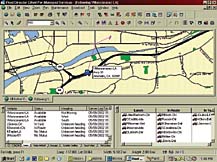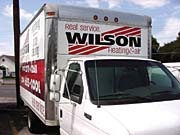Whether data is bouncing off of satellites miles above the Earth’s atmosphere or being relayed from the home office on the other side of town, having timely and accurate information is a great competitive advantage. The News asked some software providers to talk about their products and explain how they benefit technicians in the field.

Data-Basics has a program named SAM Pro Enterprise, which encompasses dispatching, preventive maintenance, field service, billing, job costing, and financials.
“Information entered from one source (e.g., the dispatcher, remote techs, the accounts receivable clerk) is immediately available throughout the system,” said Knox.
“For example, the system can automatically page a technician when a work order is assigned to him or fax the parts manager if a work order’s escalation status is set to waiting parts. Because Escalation Manager automates many of the tasks previously requiring human intervention, it provides a nearly immediate ROI for service departments.
“With Escalation Management, dispatching information is automatically sent to technicians via a remote device, fax, or page. Technicians use their remote devices to update work order status, add time and materials, enter CSR requests, etc. This information is immediately available to dispatching, billing, account managers, etc.”
Knox thinks wireless communication will continue to expand. “With the reduction in price of wireless devices, the benefits of enhanced communications with the field are available to more and more contractors.”

Increasing Productivity
“Many HVACR professionals are on the road much of the day going from job to job,” said Tim Van Cleve, chief operating officer for Teletrac, Whitestone, N.Y. (www.teletrac.net). “Our software is a tool to ensure that HVACR employees are meeting productivity and customer service goals.”Van Cleve outlined a typical scenario. “In terms of customer service, if a customer called an HVACR company with an emergency, like a burst pipe, the dispatcher could look on his computer screen, locate the closest driver to the customer, and send the driver an in-vehicle text message redirecting him to the new job in very little time.”
The software is designed not only to help techs in the field, but also to help those managing the home office. “Teletrac’s flagship fleet tracking product, FleetDirector, gives fleet managers the ability to track the location of their vehicles, viewing them in real time over maps on their computer screen,” said Van Cleve. “This gives fleet managers the tools to ensure that their employees are meeting productivity goals and fulfilling the needs of their customers. Our software also gives dispatchers the ability to communicate with drivers in the field with wireless text messages sent to the driver’s dashboard terminal. Drivers can send free text messages back to the dispatcher. Through the ‘Alert’ feature, an assigned employee can receive messages on their cell phone, pager, or e-mail, alerting them to important information.”

“FleetDirector also cuts down on fuel costs, as fleet managers can monitor drivers to make sure they stay on course during the day. The system can also alert managers if drivers use the vehicle for personal use off hours, further reducing fuel and maintenance costs.”
Van Cleve said communication software addresses two important needs: security and education.
“Security is becoming a big issue,” he said. “Wireless tracking solutions give users the ability to locate and recover stolen vehicles quickly. In addition, education is important, as the industry still has not recognized the full amount of valuable information that fleet tracking systems can generate. Many times users spend a lot of time and money trying to get data from other sources that a fleet tracking system can easily provide.”

Multi-Tasking
Melissa Berg-Baker, public relations manager for Minorplanet Systems USA, Richardson, Texas (www.minorplanetusa.com) said that the dispatch/communication software her company sells has almost too many features to list.“Minorplanet’s 6.5 version of its Vehicle Management Information (VMI) software will be available by the time this issue is published,” she said. “There are several upgrades to the current system.” Some of the features include:
Berg-Baker listed three reasons why the HVACR trade could benefit from her company’s product.
1. Increased productivity — “Businesses with Minorplanet’s VMI system are able to add more jobs per day and increase revenue.”
2. Decreased fuel expenses — “Vehicles can now be monitored for excessive idling, route deviations, or personal vehicle use without company permission.”
3. Reduced overtime costs — “Because the system monitors vehicles minute-by-minute, business owners can verify worker timesheets.” (See related story below for a VMI case history.)
“As technology continues to become more user friendly and less expensive, even the smallest business owners/contractors (even with as few as three vehicles) will realize the benefits of systems like ours,” said Berg-Baker. “It’s happening right now, but we believe it will rapidly accelerate in the near future. The addition of new features, such as route planning and job scheduling, will also increase acceptance of this technology.
“Developing high-speed data networks is also a trend we see now and one that will continue to grow. As more customers realize the benefits of fleet management systems and other GPS-based technologies, businesses will need to transfer large quantities of data quickly and cheaply.”
Tracking And More
Todd Lewis, president of GPS-North America, Holland, Pa. (www.gpstracking.com) said that his company, which sells Global Positioning System (GPS) tracking software, offers many other different functions.“We offer a dispatch function that finds the closest vehicle to a service call,” he said. “Our GPS Tracking product can also be used as a wireless data port to transmit data from a field force automation device used to capture signatures, complete orders, or bar code scan deliveries. Any hand-held device can plug into the RS232 port on our GPS unit.
“This reduces fees associated with wireless data transmission because the information is bundled with the GPS location transmission. We can also integrate any data we collect about a vehicle directly into any custom software package.
“We also offer navigation services that give a driver turn-by-turn directions and two-way text messaging. We will be offering an optional scheduling and routing option later this summer.”
It is all about integration, according to Lewis. “Companies are looking to integrate information we collect into their own custom applications,” he noted. “They need to improve efficiency of operations, reduce waste, and maximize profitability.”

Sidebar: A Vehicle Management Case Study
DALLAS — Minorplanet USA offered the following case study to illustrate the effectiveness of its Vehicle Management Information (VMI) software. The client, Wilson Heating & Air Inc., is a family-run business that provides sales, installation, and maintenance services for residential and commercial air conditioning and heating systems throughout Dallas and the surrounding North Texas area.Company management wanted to cut down on unnecessary fuel and maintenance costs. In addition, the ability to control and monitor all aspects of the fleet was important to maximize productivity and reduce payroll expense.
After installing VMI software, Wilson Heating & Air noted benefits in:
Officials said the company experienced a $300,000 increase in revenue and additional savings of at least $175,000.
— John R. Hall
Publication date: 06/09/2003



